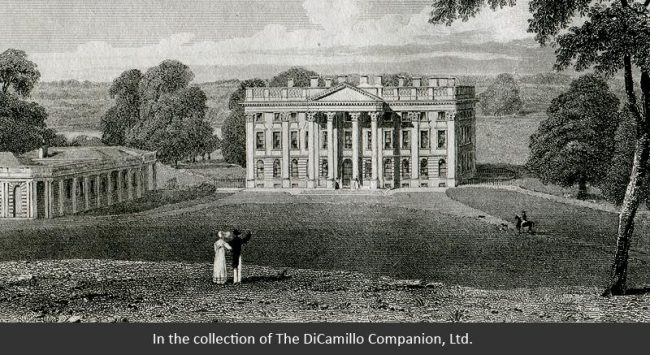
An 1819 engraving of the house from "Neale's Views of the Seats of the Noblemen and Gentlemen in England, Wales, Scotland and Ireland."
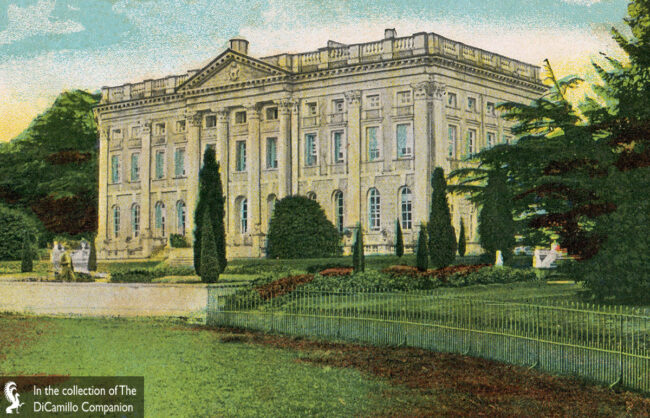
The house from a 1906 postcard
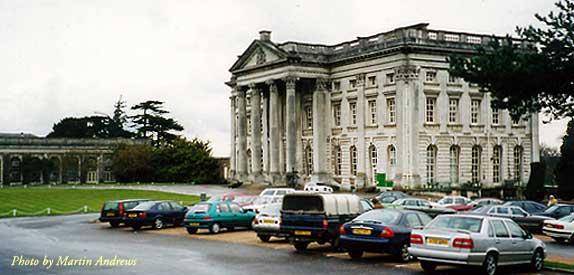
The house in the 1990s
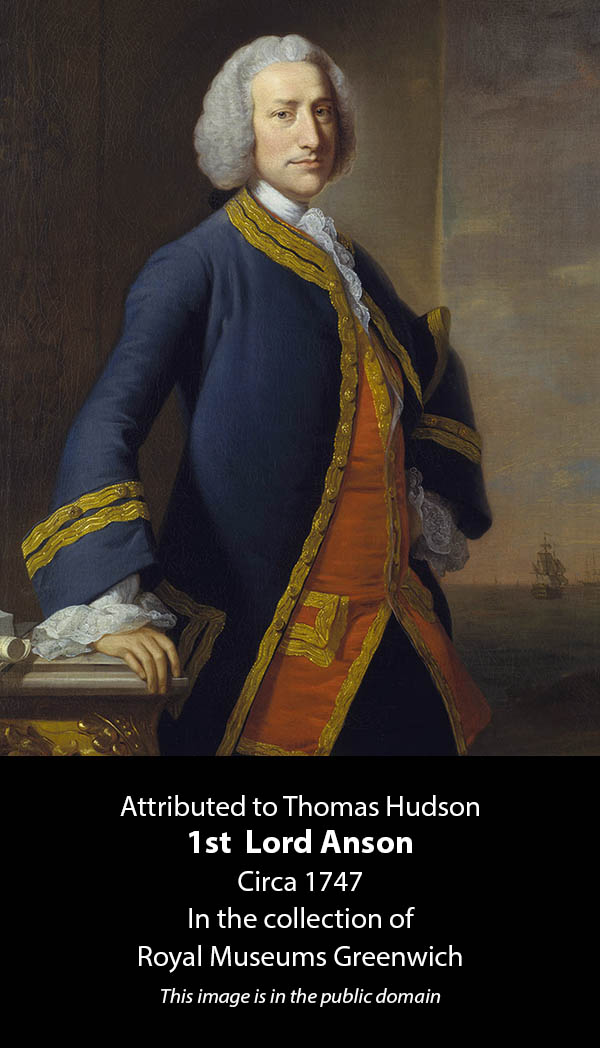
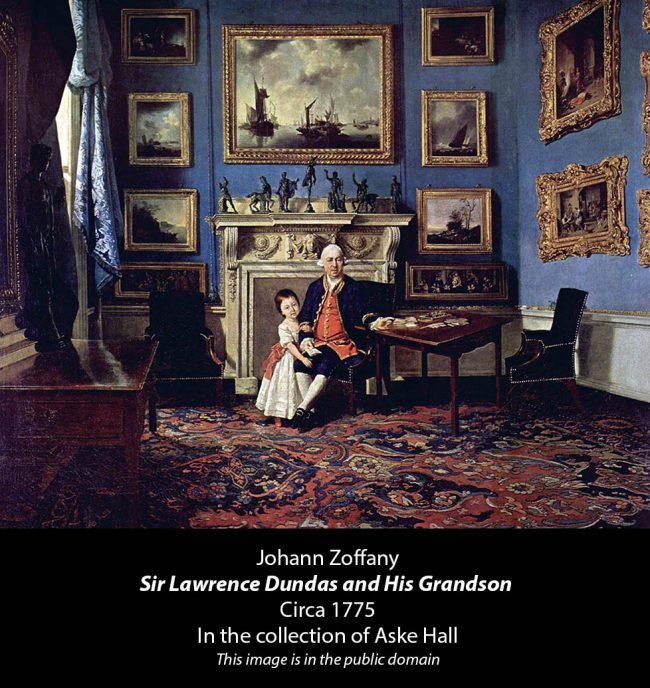
In this famous conversation piece, Sir Lawrence Dundas is shown in one of the Robert Adam-designed rooms of his London townhouse, 19 Arlington Street. Purchased by Sir Lawrence in 1763 for £15,000, 19 Arlington remained the Dundas family’s London home until it was demolished in 1936 and replaced by an apartment building.
Earlier Houses: There was an earlier Medieval house that was replaced by the current house.
House & Family History: The current house was built 1678–84 to the designs of Hugh May for Charles II's illegitimate son, James, Duke of Monmouth (the cornice of the house was copied from Cassiobury Park, a house recently begun by May). Moor Park cost the immense sum of £86,000 to complete (approximately £168 million in 2012 inflation-adjusted values using commodity labor value index). After Monmouth's beheading on July 15, 1685 for treason, Moor Park was inherited by his wife, Anne Scott, 1st Duchess of Buccleuch, who sold the estate in the 1720s to Benjamin Hoskins Styles. Styles, who had made a fortune in the South Sea Company, immediately began an extensive remodeling campaign, using Giacomo Leoni as his principal architect. Leoni refaced the house with Portland stone and added the Corinthian portico on the West Façade and Tuscan colonnades (since removed). Inside, Leoni worked with Sir James Thornhill, who painted the Great Hall and the staircase, complete with a dome in imitation St. Peter's, Rome (Thornhill, who was famously difficult, quarreled with Styles and left the project before its completion). In 1751 Moor Park was bought by Admiral Lord Anson (see "Images" section), who engaged Matthew Brettingham the Elder for alterations. After Lord Anson's death in 1762, Moor was purchased for £25,000 by Sir Lawrence Dundas, who spent huge sums refurnishing the house. Sir Lawrence had a spectacularly successful career. The second son of Thomas Dundas, a draper from Perthshire, Lawrence began his professional life as a modestly successful wine merchant. He hit the big time in the 1750s, when he was appointed commissary general to the forces during the Seven Years' War. This position, in which he supplied goods to the British Army, enabled Lawrence to amass a great fortune, which he used to become a successful banker and Whig politician. Made a baronet in 1762, Sir Lawrence used his great wealth to buy houses and estates in England, Scotland, and Ireland. A member of the Society of Dilettanti, and a man of great taste, he formed large and important art collections at his houses and commissioned furniture and fittings from the finest makers of the day, including Thomas Chippendale, John Cobb, and William Vile (see “Images” section for Zoffany painting of Sir Lawrence and his grandson in his London townhouse). At his death in 1781, Sir Lawrence left his son an immense fortune of £900,000 (over £1 billion in 2019 inflation-adjusted values using the labour value commodity index). Sir Lawrence is buried in the Dundas Mausoleum at Falkirk Old Parish Church. In 1828 the Moor Park Estate was sold to the Grosvenor family, who engaged a number of architects in a series of alterations and additions throughout the 19th century. During World War II the house was requisitioned by the government as the headquarters of the 1st Airborne Corps, who planned Operation Market Garden here. Moor Park Golf Club now has its clubhouse in the house.
Collections: In the 1760s and 1770s Sir Lawrence Dundas lavishly refurnished the house and installed an important collection of paintings. He eventually had over 100 canvases in his collection, including works by Rubens, Raphael, Cuyp, Teniers, and Murillo. Sir Lawrence also ordered a set of Gobelins tapestries with medallions by François Boucher (today in the collection of Aske Hall). There are similar Gobelin tapestry sets, called the Tentures de Boucher, that were made for Croome Court, Worcestershire (today in the collection of the Metropolitan Museum of Art); Weston Park, Shropshire; Osterley Park, London; and Newby Hall, Yorkshire. Sir Lawrence also commissioned a suite of Robert Adam-designed furniture that was among the first English furniture made in the Neoclassical style. Following Sir Lawrence's death, Moor Park was sold by his son, Thomas, and the contents dispersed and scattered. Much of the collection went to the family's London townhouse, 19 Arlington Street (demolished in 1936), and the Dundas country seat, Aske Hall in Yorkshire. Many of the pieces of the collection that weren't kept by the family were sold by Sotheby's in the 1780s. In addition, between May 29 and 31, 1794, Messrs. Greenwood sold 116 of Sir Lawrence's paintings in their London auction rooms at Leicester Square.
Architect: James Thornhill
Date: 1720sArchitect: Matthew Brettingham the Elder
Date: 1751-54Architect: William Burn
Date: 1849Architect: Thomas Cundy, Jr.
Date: Circa 1830Architect: Giacomo Leoni
Date: 1720sArchitect: Robert Adam
Date: 1763-65Vitruvius Britannicus: C. V, pls. 50-55, 1771.
John Bernard (J.B.) Burke, published under the title of A Visitation of the Seats and Arms of the Noblemen and Gentlemen of Great Britain and Ireland, among other titles: Vol. II, p. 81, 1853.
John Preston (J.P.) Neale, published under the title of Views of the Seats of Noblemen and Gentlemen in England, Wales, Scotland, and Ireland, among other titles: Vol. II, 1819.
Country Life: XLVI, 386, 1919.
Title: Biographical Dictionary of British Architects, 1600-1840, A - HARDBACK
Author: Colvin, Howard
Year Published: 2008
Reference: pg. 1039
Publisher: New Haven: Yale University Press
ISBN: 9780300125085
Book Type: Hardback
Title: Creating Paradise: The Building of the English Country House, 1660-1880
Author: Wilson, Richard; Mackley, Alan
Year Published: 2000
Reference: pg. 243
Publisher: London: Hambledon and London
ISBN: 1852852526
Book Type: Hardback
Title: Movie Locations: A Guide to Britain & Ireland
Author: Adams, Mark
Year Published: 2000
Publisher: London: Boxtree
ISBN: 0752271695
Book Type: Softback
Title: Biographical Dictionary of British Architects, 1600-1840, A - SOFTBACK
Author: Colvin, Howard
Year Published: 1995
Reference: pgs. 58, 156, 190, 286, 648
Publisher: New Haven: Yale University Press
ISBN: 0300072074
Book Type: Softback
House Listed: Grade I
Park Listed: Grade II*
Past Seat / Home of: SEATED AT EARLIER HOUSE: Archbishop Neville of York, 15th century. Cardinal Wolsey, 16th century. King Henry VIII, 16th century. SEATED AT CURRENT HOUSE: James Scott, 1st Duke of Monmouth and 1st Duke of Buccleuch, 1680-85; Anne Scott, 1st Duchess of Buccleuch, 1685-1720. Benjamin Hoskins Styles, 1720-54. Admiral of the Fleet George Anson, 1st Baron Anson, 1754-62; Thomas Anson, 1762-63. Sir Lawrence Dundas, 1st Bt., 1763-81; Sir Thomas Dundas, 2nd Bt., 1781-84. Robert Grosvenor, 1st Lord Ebury, 19th century. Robert Williams, 19th century. Robert Grosvenor, 1st Marquess of Westminster, 19th century.
Current Ownership Type: Other
Primary Current Ownership Use: Country Club / Golf Club
Ownership Details: Today Moor Park Golf Club
House Open to Public: No
Phone: 01923-773-146
Fax: 01923-777-109
Email: [email protected]
Website: http://www.moorparkgc.co.uk
Historic Houses Member: No